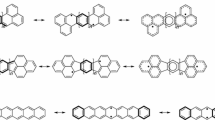Abstract
Context and results
This study aimed to obtain potential energy curves within a multireference 4-component relativistic method and to present spectroscopic constants (R\(_e\),\(\omega _{e}\),\(\omega _{e}\)x\(_e\),\(\omega _{e}\)y\(_e\), D\(_e\), D\(_0\), B\(_e\),\(\alpha _{e}\),\(\beta _{e}\),\(\gamma _{e}\) ), accurate extended Rydberg analytical form, and rovibrational levels for the 6 low-lying states of the I\(_2^{-}\) anion. For these states, some spectroscopic constants, rovibrational levels, and an accurate analytical form are presented for the first time in literature, and they are of interest for femtosecond and dynamics experiments of I\(_2^{-}\) as well as for electron attachment of I\(_2\). This study suggests that the inclusion of relativistic and correlation effects treated at the MRCISD+Q level is needed to obtain reliable results, specially for D\(_e\).
Computational and theoretical techniques
The potential energy curves of the ground and the excited states of the molecular iodine anion (I\(_2^{-}\)) were investigated at multireference configuration interaction (MRCISD) with Davidson size-extensivity correction (denoted as +Q) within a fully relativistic four-component relativistic framework including Breit interaction.

Similar content being viewed by others
Availability of data and materials
All data generated or analyzed during this study were included in this published article.
Code Availability
Not Applicable
References
Küpper FC, Feiters MC, Olofsson B, Kaiho T, Yanagida S, Zimmermann MB, Carpenter LJ, Luther GW III, Lu Z, Jonsson M et al (2011) Commemorating two centuries of iodine research: an interdisciplinary overview of current research. Angewandte Chemie International Edition 50(49):11598–11620
Svensson PH, Kloo L (2003) Synthesis, structure, and bonding in polyiodide and metal iodide-iodine systems. Chemical Reviews 103(5):1649–1684
Grätzel M (2005) Solar energy conversion by dye-sensitized photovoltaic cells. Inorganic Chemistry 44(20):6841–6851
Ma J, Liu M, He Y, Zhang J (2021) Iodine redox chemistry in rechargeable batteries. Angewandte Chemie International Edition 60(23):12636–12647
Zhang S, Tan X, Meng Z, Tian H, Xu F, Han W-Q (2018) Naturally abundant high-performance rechargeable aluminum/iodine batteries based on conversion reaction chemistry. J of Materials Chemistry A 6(21):9984–9996
Levi BG (2000) Nobel prize in chemistry salutes the discovery of conducting polymers. Physics Today 53(12):19–22
Shirakawa H (2001) The discovery of polyacetylene film: the dawning of an era of conducting polymers (nobel lecture). Angewandte Chemie International Edition 40(14):2574–2580
Rasmussen SC, Rasmussen SC (2018) 2000 nobel prize in chemistry. Acetylene and Its Polymers. 150+ Years of History, 125–132
Rasmussen SC (2021) New insight into the “fortuitous error” that led to the 2000 nobel prize in chemistry.Substantia 5(1)
Sanov A, Sanford T, Nandi S, Lineberger WC (1999) Spin-orbit relaxation and recombination dynamics in i 2(co 2) n and i 2-(ocs) n cluster ions: A new type of photofragment caging reaction. The Journal of Chemical Physics 111(2):664–675
Greenblatt BJ, Zanni MT, Neumark DM (2000) Femtosecond photoelectron spectroscopy of i 2(co 2) n clusters (n= 4, 6, 9, 12, 14, 16). The Journal of Chemical Physics 112(2):601–612
Vorsa V, Campagnola PJ, Nandi S, Larsson M, Lineberger W (1996) Photofragmentation of i2 ar n clusters. Observation of metastable isomeric ionic fragments. The Journal of Chemical Physics 105(6): 2298–2308
Vorsa V, Nandi S, Campagnola PJ, Larsson M, Lineberger W (1997) Recombination dynamics of photodissociated i 2 in size selected ar and co2 clusters. The Journal of Chemical Physics 106(4):1402–1410
Davis AV, Wester R, Bragg AE, Neumark DM (2003) Time-resolved photoelectron imaging of the photodissociation of i 2-. The Journal of Chemical Physics 118(3):999–1002
Gibbard J, Continetti R (2019) Photoelectron-photofragment coincidence spectroscopy of the dissociative photodetachment of i2-at 258 and 266 nm. Molecular Physics 117(21):3056–3065
Gibbard J, Castracane E, Continetti R (2020) Photoelectron-photofragment coincidence spectroscopy of the mixed trihalides. The Journal of Chemical Physics 153(5):054304
Yadav H, Vinodkumar M, Limbachiya C, Vinodkumar P, Mason N (2020) Low energy electron interactions with iodine molecule (i2). Journal of Quantitative Spectroscopy and Radiative Transfer 250:107035
Batista VS, Zanni MT, Greenblatt BJ, Neumark DM, Miller WH (1999) Femtosecond photoelectron spectroscopy of the i 2- anion: a semiclassical molecular dynamics simulation method. The Journal of Chemical Physics 110(8):3736–3747
Zanni MT, Davis AV, Frischkorn C, Elhanine M, Neumark DM (2000) Femtosecond stimulated emission pumping: Characterization of the i 2-ground state. The Journal of Chemical Physics 112(20):8847–8854
Mabbs R, Pichugin K, Sanov A (2005) Dynamic molecular interferometer: Probe of inversion symmetry in i 2-photodissociation. The Journal of Chemical Physics 123(5):054329
Zanni MT, Batista VS, Greenblatt BJ, Miller WH, Neumark DM (1999) Femtosecond photoelectron spectroscopy of the i 2\(^-\) anion: Characterization of the ã 2 \(\pi \) g, 1/2 excited state. The Journal of Chemical Physics 110(8):3748–3755
Davis AV, Wester R, Bragg AE, Neumark DM (2002) Vibrational relaxation in clusters: Energy transfer in i 2(co 2) 4 excited by femtosecond stimulated emission pumping. The Journal of Chemical Physics 117(9):4282–4292
Xiang-Yang M, Xin L, He-Shan S (2008) Probing wave packet dynamics of i2\(^-\) anions with pump-probe femtosecond spectroscopy. Chinese Physics Letters 25(3):915
Zanni MT, Taylor TR, Greenblatt BJ, Soep B, Neumark DM (1997) Characterization of the i 2- anion ground state using conventional and femtosecond photoelectron spectroscopy. The Journal of Chemical Physics 107(19):7613–7619
Chen E, Wentworth W (1985) Negative ion states of the halogens. The Journal of Physical Chemistry 89(19):4099–4105. https://doi.org/10.1021/j100265a035
Dojahn J, Chen E, Wentworth W (1996) Characterization of homonuclear diatomic ions by semiempirical morse potential energy curves. 1. the halogen anions. The Journal of Physical Chemistry 100(23): 9649–9657. https://doi.org/10.1021/jp953601z
Chen E, Dojahn J, Wentworth W (1997) Characterization of homonuclear diatomic ions by semiempirical morse potential energy curves. 2. the rare gas positive ions. The Journal of Physical Chemistry A 101(17): 3088–3101
Tasker P, Balint-Kurti GG, Dixon R (1976) A calculation of the potential curves for the halogen molecule negative ions. Molecular Physics 32(6):1651–1660
Bowmaker GA, Schwerdtfeger P, Von Szentpály L (1989) Pseudopotential and multiple scattering x\(\alpha \) calculations of nuclear quadrupole coupling constants and other properties of diatomic halogen molecules and their monoanions and monocations. Journal of Molecular Structure: THEOCHEM 184(1–2):87–101
Danovich D, Hrušák J, Shaik S (1995) Ab initio calculations for small iodo clusters. good performance of relativistic effective core potentials. Chemical Physics Letters 233(3): 249–256
Maslen P, Faeder J, Parson R (1996) Ab initio calculations of the ground and excited states of i2- and icl-. Chemical Physics Letters 263(1–2):63–72
Vala J, Kosloff R, Harvey JN (2001) Ab initio and diatomics in molecule potentials for i 2-, i 2, i 3-, and i 3. The Journal of Chemical Physics 114(17):7413–7423
Sharp SB, Gellene GI (2000) Mrcisd calculations of the six lowest valence states of i2-. Molecular Physics 98(10):667–675
Visscher L, Eliav E, Kaldor U (2001) Formulation and implementation of the relativistic fock-space coupled cluster method for molecules. The Journal of Chemical Physics 115(21):9720–9726
de Jong WA, Visscher L, Nieuwpoort WC (1997) Relativistic and correlated calculations on the ground, excited, and ionized states of iodine. The Journal of Chemical Physics 107(21):9046–9058
de Macedo LGM, de Jong WA (2008) Fully relativistic calculations on the potential energy surfaces of the lowest 23 states of molecular chlorine. The Journal of Chemical Physics 128(4):041101. https://doi.org/10.1063/1.2827457
Gomes JDS, Gargano R, Martins JB, de Macedo M, LG, (2014) Relativistic four-component potential energy curves for the lowest 23 covalent states of molecular bromine (br2). The Journal of Physical Chemistry A 118(31):5818–5822
Lima A, da Rocha J, Amador D, de Macedo L (2016) Theoretical study of 23 covalent states of the f2 molecule by relativistic methodology mrci 4 components. Revista Virtual De Quimica 8(2):405–416. https://doi.org/10.1021/jp4114283
de Macedo LGM, Neves ER, de Oliveira Só YA, Gargano R (2021) Relativistic four-component potential energy curves for the lowest 23 covalent states of molecular astatine (at2): Spectrochimica Acta Part A. Molecular and Biomolecular Spectroscopy 245:118869. https://doi.org/10.1016/j.saa.2020.118869
de Macedo LGM, Wanzeler HP, Dias GHL, Gargano R (2021) Relativistic four-component mrcisd+ q calculations of the six lowest valence states of molecular f 2- _2\(^-\)anion including breit interactions. Journal of Molecular Modeling 27:1–8
Visscher L, Visser O, Aerts PJ, Merenga H, Nieuwpoort W (1994) Relativistic quantum chemistry: the molfdir program package. Computer Physics Communications 81(1–2):120–144. https://doi.org/10.1016/0010-4655(94)90115-5
Visscher L, Dyall K (1996) Relativistic and correlation effects on molecular properties. i. the dihalogens f2, cl2, br2, i2, and at2. The Journal of Chemical Physics 04(22): 9040–9046. https://doi.org/10.1063/1.471636
Visscher L, Dyall KG (1997) Dirac-fock atomic electronic structure calculations using different nuclear charge distributions. Atomic Data and Nuclear Data Tables 67(2):207–224. https://doi.org/10.1006/adnd.1997.0751
Visser O, Visscher L, Aerts P, Nieuwpoort W (1992) Molecular open shell configuration interaction calculations using the dirac-coulomb hamiltonian: The f 6-manifold of an embedded euo9- 6 cluster. The Journal of Chemical Physics 96(4):2910–2919. https://doi.org/10.1063/1.461987
Breit G (1929) The effect of retardation on the interaction of two electrons. Physical Review 34(4):553. https://doi.org/10.1103/PhysRev.34.553
Gaunt JA (1929) Iv. the triplets of helium:Philosophical Transactions of the Royal Society of London. Series A, Containing Papers of a Mathematical or Physical Character 228(659-669): 151–196. https://doi.org/10.1098/rsta.1929.0004
Langhoff SR, Davidson ER (1974) Configuration interaction calculations on the nitrogen molecule. International Journal of Quantum Chemistry 8(1):61–72. https://doi.org/10.1002/qua.560080106
Fdez. Galvan I, Vacher M, Alavi A, Angeli C, Aquilante F, Autschbach J, Bao JJ, Bokarev SI, Bogdanov NA, Carlson, et al (2019) Openmolcas: From source code to insight. Journal of Chemical Theory and Computation 15(11):5925–5964. https://doi.org/10.1021/acs.jctc.9b00532
Dunham J (1932) The energy levels of a rotating vibrator. Physical Review 41(6):721. https://doi.org/10.1103/PhysRev.41.721
Vila HVR, Leal LA, Ribeiro LA, Martins JBL, e Silva GM, Gargano R, (2012) Spectroscopic properties of the h2+ molecular ion in the 8k\(\pi \), 9k\(\sigma \), 9l\(\pi \), 9l\(\sigma \) and 10o\(\sigma \) electronic states. Journal of Molecular Spectroscopy 273:26–29. https://doi.org/10.1016/j.jms.2012.02.002
Soares Neto J, Costa L (1998) Numerical generation of optimized discrete variable representations. Brazilian Journal of Physics 28(1):1–11. https://doi.org/10.1590/S0103-97331998000100001
Murrell J, Carter S, Farantos S, Huxley P, Varandas A Molecular potential energy functions, 1984 John Wiley &Sons, Chichester \(\{\)West Sussex\(\}\), New York
Powell MJ (1964) An efficient method for finding the minimum of a function of several variables without calculating derivatives. The Computer Journal 7(2):155–162. https://doi.org/10.1093/comjnl/7.2.155
Acknowledgements
This work was supported by Universidade Federal de São João del Rei (CCO/UFSJ). YCCV thanks Conselho Nacional de Desenvolvimento Científico e Tecnológico (CNPQ) for his PIBIC scholarship. LGMM thanks Conselho Nacional de Desenvolvimento Científico e Tecnológico (CNPQ) for financial support under grant 408085/2021-5. RG also thanks the CNPQ and FAPDF for financial support.
Funding
This work was funded by Conselho Nacional de Desenvolvimento Científico e Tecnológico (CNPQ) (grant 408085/2021-5).
Author information
Authors and Affiliations
Contributions
Ricardo Gargano (RG) and Luiz Guilherme Machado de Macedo (LGMM) contributed to the study’s conception. All authors contributed to the investigation. Yasmin Celen de Castro Vieira (YCCV) prepared all the figures. Rhuiago Mendes de Oliveira prepared the Rydberg fitting. The first draft of the manuscript was written by Luiz Guilherme Machado de Macedo (LGMM). Ricardo Gargano (RG) and Luiz Guilherme Machado de Macedo (LGMM) were responsable for funding acquisition and resources. The review and editing of the final form of the manuscript were made by Ricardo Gargano (RG) and Luiz Guilherme Machado de Macedo (LGMM). All authors have read and approved the final manuscript.
Corresponding author
Ethics declarations
Conflict of interest
The authors declare no competing interests.
Ethics approval
Not Applicable.
Additional information
Publisher's Note
Springer Nature remains neutral with regard to jurisdictional claims in published maps and institutional affiliations.
Yasmin Celen de Castro Vieira, Rhuiago Mendes de Oliveira and Ricardo contributed equally to this work
This paper belongs to the Topical Collection IX Symposium on Electronic Structure and Molecular Dynamics - IX SeedMol.
Supplementary Information
Below is the link to the electronic supplementary material.
Rights and permissions
Springer Nature or its licensor (e.g. a society or other partner) holds exclusive rights to this article under a publishing agreement with the author(s) or other rightsholder(s); author self-archiving of the accepted manuscript version of this article is solely governed by the terms of such publishing agreement and applicable law.
About this article
Cite this article
de Macedo, L.G.M., de Castro Vieira, Y.C., de Oliveira, R.M. et al. Relativistic four-component MRCISD+Q calculations of the six lowest valence states of molecular \(\text {I}_{2}^{-}\) anion including breit interactions. J Mol Model 29, 207 (2023). https://doi.org/10.1007/s00894-023-05564-x
Received:
Accepted:
Published:
DOI: https://doi.org/10.1007/s00894-023-05564-x




